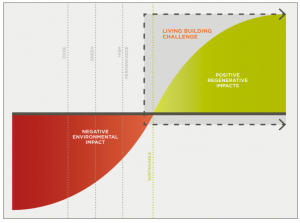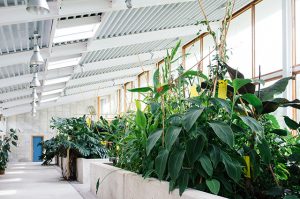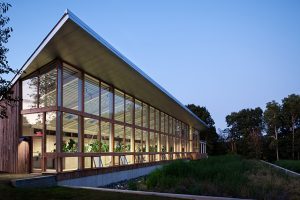 Have you ever considered how a flower functions? It lives off the resources available to it, using the sun, water and soil in its immediate surroundings to thrive. It also provides a service to its surrounding environment, in the way of food, shelter and aesthetic beauty. This is what a building following the Living Building Challenge® certification is designed to emulate.
Living Building Challenge (LBC) was created by the Cascadia Green Building Council in 2006. It was born from the concept that a building should not only be energy efficient, but also have a positive impact on its residents and the community. Buildings that take on the Challenge go above and beyond typical high performance buildings. The aim of LBC is to reduce the energy and water footprint of a building down to the amount it can produce on site. In addition, LBC asks buildings to connect residents and communities with healthy, beautiful and renewing environments. These are very tall orders!
Have you ever considered how a flower functions? It lives off the resources available to it, using the sun, water and soil in its immediate surroundings to thrive. It also provides a service to its surrounding environment, in the way of food, shelter and aesthetic beauty. This is what a building following the Living Building Challenge® certification is designed to emulate.
Living Building Challenge (LBC) was created by the Cascadia Green Building Council in 2006. It was born from the concept that a building should not only be energy efficient, but also have a positive impact on its residents and the community. Buildings that take on the Challenge go above and beyond typical high performance buildings. The aim of LBC is to reduce the energy and water footprint of a building down to the amount it can produce on site. In addition, LBC asks buildings to connect residents and communities with healthy, beautiful and renewing environments. These are very tall orders!

Courtesy: International Living Future Institute
- Place – outlines the acceptable areas to build and how to protect and restore the area once it is built.
- Water – requires the collection and recycling of the water used within the building.
- Energy – requires buildings to be net-positive energy, relying solely on renewable energy sources.
- Health + Happiness – outlines conditions that must be present in a building to encourage healthy spaces and increased productivity.
- Materials – requires building materials used throughout construction to be non-toxic, transparent and socially equitable.
- Equity – focuses on creating communities that are accessible to all people, regardless of age, socioeconomic status and physical abilities.
- Beauty – places importance on creating aesthetically pleasing spaces.
 Each Petal has standout Imperatives that highlight that particular performance area. For example, the Place Petal contains an Imperative called Habitat Exchange, which requires projects to set aside land area equal to the development area in perpetuity. Both the Water and the Energy Petals have just one Imperative each, requiring net-positive water and net-positive energy. Biophilic Environment is an important Imperative within the Health + Happiness Petal, requiring buildings to connect residents to natural elements using principles of biophilic design.
The Materials Petal contains some of the most difficult requirements, including the Red List Imperative, which prohibits the use of certain materials in the entire project. Some of the materials on the Red List are PVC, wood treatments, neoprene and formaldehyde. The Equity Petal contains the Equitable Investment Imperative, which requires developments to donate a half a cent or more to charity for every dollar of project cost. Finally, the Beauty Petal includes the Inspiration + Education Imperative, which requires education of the operation and performance of the building to be available to the public.
When compared to well-known green building standards like LEED and Passive House, LBC clearly is at a different level which can be daunting to many designers and developers. However, as of March 2017, there are nearly 365 registered projects in 23 countries around the world. While only twelve projects have been certified so far, there is clearly a trend towards eliminating the negative impact the built environment has on people and the ecosystem.
Each Petal has standout Imperatives that highlight that particular performance area. For example, the Place Petal contains an Imperative called Habitat Exchange, which requires projects to set aside land area equal to the development area in perpetuity. Both the Water and the Energy Petals have just one Imperative each, requiring net-positive water and net-positive energy. Biophilic Environment is an important Imperative within the Health + Happiness Petal, requiring buildings to connect residents to natural elements using principles of biophilic design.
The Materials Petal contains some of the most difficult requirements, including the Red List Imperative, which prohibits the use of certain materials in the entire project. Some of the materials on the Red List are PVC, wood treatments, neoprene and formaldehyde. The Equity Petal contains the Equitable Investment Imperative, which requires developments to donate a half a cent or more to charity for every dollar of project cost. Finally, the Beauty Petal includes the Inspiration + Education Imperative, which requires education of the operation and performance of the building to be available to the public.
When compared to well-known green building standards like LEED and Passive House, LBC clearly is at a different level which can be daunting to many designers and developers. However, as of March 2017, there are nearly 365 registered projects in 23 countries around the world. While only twelve projects have been certified so far, there is clearly a trend towards eliminating the negative impact the built environment has on people and the ecosystem.
 One of the twelve certified projects is the Omega Center for Sustainable Living in Rhinebeck, New York. This project is a wastewater filtration facility for the Omega campus, and also is used as an educational tool to teach people about its ecological impacts. One of highlights of this building is its net-zero water system. Potable water comes from private wells located within the Omega campus. After use in bathroom lavatories, drinking fountains, janitorial and wash sinks, the water is treated and returned underground. In addition, storm water is collected to provide enough reserve water for 100 percent of non-potable water use every year.
Soon there will another LBC certified building in New York. Nuthatch Hollow at Binghamton University is currently under schematic design. Its primary purpose will be to serve as a teaching and research facility for the Environmental Studies Department. On a broader scale, this building will highlight the University’s core values to foster students who create a sustainable and resilient world. Construction is anticipated to begin in 2018 and the design and construction progress will be tracked through the Nuthatch Hollow blog, set up in partnership with the design team and Binghamton University.
One of the twelve certified projects is the Omega Center for Sustainable Living in Rhinebeck, New York. This project is a wastewater filtration facility for the Omega campus, and also is used as an educational tool to teach people about its ecological impacts. One of highlights of this building is its net-zero water system. Potable water comes from private wells located within the Omega campus. After use in bathroom lavatories, drinking fountains, janitorial and wash sinks, the water is treated and returned underground. In addition, storm water is collected to provide enough reserve water for 100 percent of non-potable water use every year.
Soon there will another LBC certified building in New York. Nuthatch Hollow at Binghamton University is currently under schematic design. Its primary purpose will be to serve as a teaching and research facility for the Environmental Studies Department. On a broader scale, this building will highlight the University’s core values to foster students who create a sustainable and resilient world. Construction is anticipated to begin in 2018 and the design and construction progress will be tracked through the Nuthatch Hollow blog, set up in partnership with the design team and Binghamton University.

Leave a Reply
You must be logged in to post a comment.